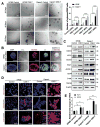Cigarette Smoke Induces Stem Cell Features of Pancreatic Cancer Cells via PAF1
- PMID: 29864419
- PMCID: PMC6120776
- DOI: 10.1053/j.gastro.2018.05.041
Cigarette Smoke Induces Stem Cell Features of Pancreatic Cancer Cells via PAF1
Abstract
Background & aims: Cigarette smoking is a major risk factor for pancreatic cancer. Aggressive pancreatic tumors contain cancer cells with stem cell features. We investigated whether cigarette smoke induces stem cell features in pancreatic cancer cells.
Methods: KrasG12D; Pdx1-Cre mice were exposed to cigarette smoke or clean air (controls) for up to 20 weeks; pancreata were collected and analyzed by histology, quantitative reverse transcription polymerase chain reaction, and confocal immunofluorescence microscopy. HPNE and Capan1 cells were exposed to cigarette smoke extract (CSE), nicotine and nicotine-derived carcinogens (NNN or NNK), or clean air (controls) for 80 days and evaluated for stem cell markers and features using flow cytometry-based autofluorescence, sphere formation, and immunoblot assays. Proteins were knocked down in cells with small interfering RNAs. We performed RNA sequencing analyses of CSE-exposed cells. We used chromatin immunoprecipitation assays to confirm the binding of FOS-like 1, AP-1 transcription factor subunit (FOSL1) to RNA polymerase II-associated factor (PAF1) promoter. We obtained pancreatic ductal adenocarcinoma (PDAC) and matched nontumor tissues (n = 15) and performed immunohistochemical analyses.
Results: Chronic exposure of HPNE and Capan1 cells to CSE caused them to increase markers of stem cells, including autofluorescence and sphere formation, compared with control cells. These cells increased expression of ABCG2, SOX9, and PAF1, via cholinergic receptor nicotinic alpha 7 subunit (CHRNA7) signaling to mitogen-activated protein kinase 1 and FOSL1. CSE-exposed pancreatic cells with knockdown of PAF1 did not show stem cell features. Exposure of cells to NNN and NNK led to increased expression of CHRNA7, FOSL1, and PAF1 along with stem cell features. Pancreata from KrasG12D; Pdx1-Cre mice exposed to cigarette smoke had increased levels of PAF1 mRNA and protein, compared with control mice, as well as increased expression of SOX9. Levels of PAF1 and FOSL1 were increased in PDAC tissues, especially those from smokers, compared with nontumor pancreatic tissue. CSE exposure increased expression of PHD-finger protein 5A, a pluripotent transcription factor and its interaction with PAF1.
Conclusions: Exposure to cigarette smoke activates stem cell features of pancreatic cells, via CHRNA7 signaling and FOSL1 activation of PAF1 expression. Levels of PAF1 are increased in pancreatic tumors of humans and mice with chronic cigarette smoke exposure.
Keywords: ERK; Nicotine Receptor Signaling; PHF5A; Pancreatic Carcinogenesis.
Copyright © 2018 AGA Institute. Published by Elsevier Inc. All rights reserved.
Conflict of interest statement
The authors disclose no conflicts
Figures







References
Publication types
MeSH terms
Substances
Grants and funding
LinkOut - more resources
Full Text Sources
Other Literature Sources
Medical
Molecular Biology Databases
Research Materials
Miscellaneous

